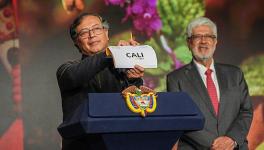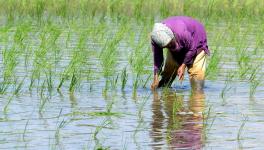Forest Conservation Must be Important Part of Global Response to COVID Pandemic
Analysing the United Nations Department of Economic and Social Affairs’ Global Forest Goals Report 2021, GYAN PATHAK writes about how forests and communities dependent on them have been impacted by the COVID-19 pandemic, and why not just responses to the pandemic, but also to the global climate change and biodiversity crises, must be rooted in the world’s forests.
THE COVID-19 pandemic is laying bare systematic vulnerabilities and inequalities in just about every economy and society. It is more than just a health crisis, as it is driving losses of lives and livelihoods, and consequently pushing more people into extreme poverty, inequality, and food security.
Apart from this onslaught of a ferocious rise in infection, the world is combating unprecedented, global crises on multiple fronts, from the escalating impact of climate change to the biodiversity crisis. For each of these complex challenges, forests and forest-dependent people are both a casualty as well as an important part of the solution.
According to the Global Forest Goals Report 2021, the world’s gross product fell by an estimated 4.3% in 2020 — the sharpest contraction of global output since the Great Depression. Such outcomes show that the pandemic is a global development emergency, with devastating consequences for those already at risk of being left behind.
The Global Forests Goals Report 2021 is the first evaluation of where the world stands in regard to implementing the United Nations (UN) Strategic Plan for Forests 2017-2030. Adopted four years ago, the Plan is a blueprint for forests and people, expressed through six Global Forest Goals and 26 targets. Outlining a vision for a future where all types of forests and trees are sustainably managed, the Plan is integral to the achievement of the UN’s 2030 Agenda for Sustainable Development.
Why forests matter
An estimated 1.6 billion people, or about 25% of the global population, rely on forests for their subsistence needs, livelihoods, employment, and income. Of the extremely poor in rural areas, 40% live in forest and savannah areas, and approximately 20% of the global population – especially women, children, landless farmers, and other vulnerable segments of society – look to forests to meet their food and income needs.
For centuries, forests have provided socio-economic safety nets for people and communities in times of crisis. The importance of forests for the well-being of people and the planet is clear. Some 1.6 billion people worldwide depend directly on forests for food, shelter, energy, medicines and income. They are home to 80 percent of all known terrestrial species, and they regulate our climate, absorbing one-third of global greenhouse gas emissions. Forests provide clean air and freshwater, and help avert desertification.
Also read: UN body urges govt to prevent potential eviction of 9 million tribal people and forest dwellers
During the COVID-19 pandemic, forests have been a lifeline for the millions of people who have turned to them for their most essential subsistence needs. They have provided us with essential health products – from masks to cleaning supplies and ethanol for sanitizers. Healthy and well-managed forests create a natural buffer against the transmission of zoonoses. Thus, forests have a critical role to play in building resilience and reducing the risk of future pandemics. Investing in forests is investing in our future.
How the pandemic has impacted forests, and those dependent on them
The COVID-19 pandemic is threatening the lifeline that forests have so often provided us. Economic contractions, disruptions to global trade and local commerce, and lockdown measures to contain the virus have affected almost 2.7 billion workers, representing approximately 81% of the world’s workforce. Forest-dependent populations are amongst this demographic.
On the economic front, they have faced job loss, reduced income, diminished access to markets and information, and for many women and youth, a contraction in seasonal employment, according to the report. Socially, many of these populations are already marginalized and vulnerable groups, those least able to access critical socio-economic safety nets, such as indigenous peoples. The report details how many forest-dependent populations, especially those in remote places, have faced difficulties accessing healthcare or have found that government assistance programmes and basic services are disrupted.
Pandemic-driven health and socio-economic outcomes have increased the pressure on forests. To ease their growing vulnerability, many indigenous peoples and local communities, as well as returning migrants and urban workers, have retreated deeper into the woods to seek food, fuel, shelter, and protection from the risks of COVID-19, details the report. As more and more vulnerable people have turned to forest products and forest resources as a coping mechanism, these ecosystems are beginning to show signs of stress. Several regions now find the stability and viability of their forest sectors in jeopardy.
How the pandemic is connected with the global climate and biodiversity crises
The impact of the pandemic is exacerbated with the escalating impact of climate change and a biodiversity crisis – global emergencies with serious implications for forest ecosystems. Among its many findings, the Global Assessment Report on Biodiversity and Ecosystem Services of the Intergovernmental Science-Policy Platform on Biodiversity and Ecosystem Services, an independent intergovernmental body, highlighted that one million species were at risk of extinction and that 100 million hectares of tropical forest were lost from 1980 to 2000.
Also read: Biodiversity is the secret behind nutrition and nourishment for our health
At the same time, climate change is jeopardizing the resilience of forest ecosystems and their ability to support ecosystem services worldwide. Though forests offer nature-based solutions to overcome these concurrent global challenges, they have also never been more at risk.
This means, according to the 2021 report, that a resilient recovery from the COVID-19 pandemic, along with responses to the climate and biodiversity crises, must be rooted in the world’s forests. The path forward needs to be paved with greater sustainability and a greener, more inclusive economy, of which healthy forest ecosystems and forest-dependent communities are an integral part.
The 2021 report explains that sustainably resourced and managed forests can bolster employment, reduce the risk of natural disasters, and provide food security and social safety nets, for starters. They can also protect biodiversity, and advance both climate mitigation and adaptation. Safeguarding and restoring forests, the 2021 report advises, will help reduce the risk of future zoonotic disease outbreaks, thereby protecting global health. (IPA Service)
The article was originally published in The Leaflet.
Get the latest reports & analysis with people's perspective on Protests, movements & deep analytical videos, discussions of the current affairs in your Telegram app. Subscribe to NewsClick's Telegram channel & get Real-Time updates on stories, as they get published on our website.
























